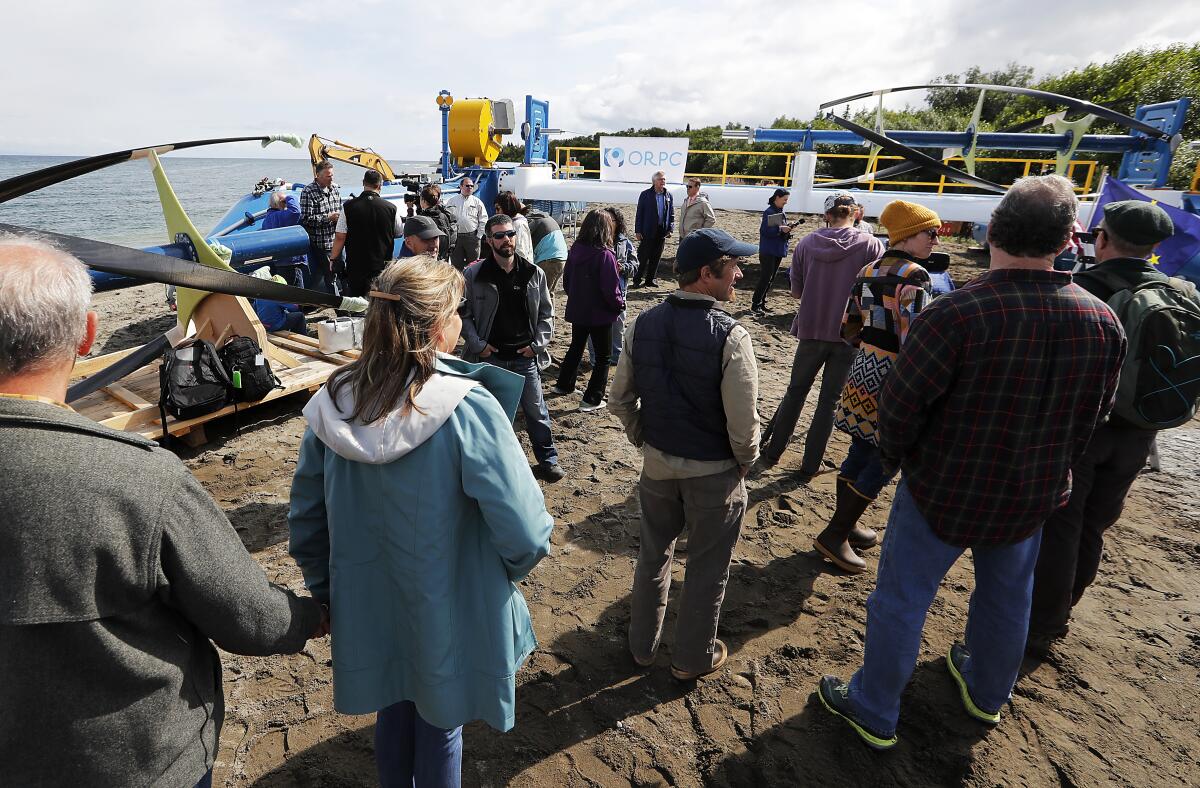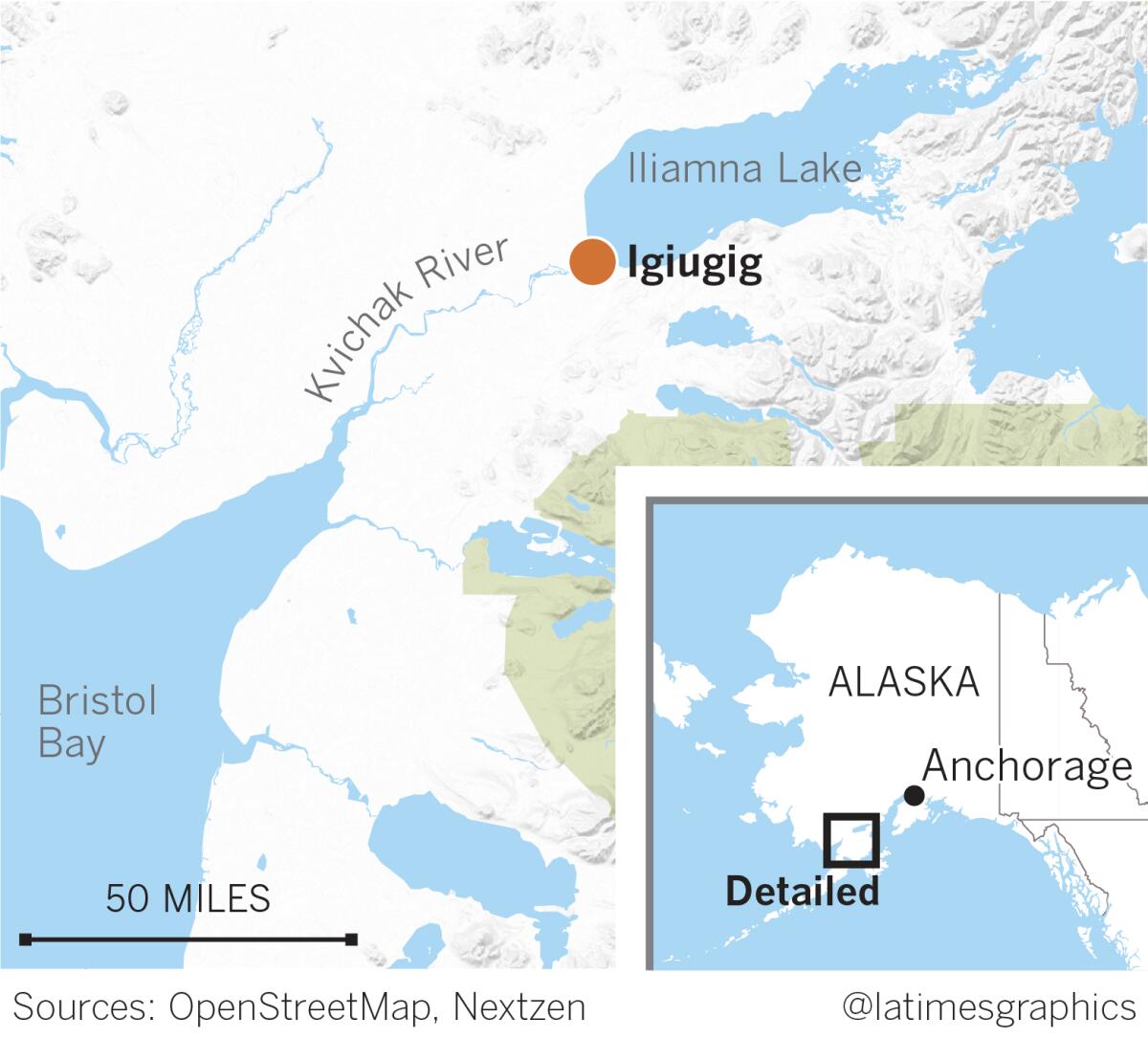Path to paradise? Alaskan village hopes to replace fossil fuel with water power

- Share via
IGIUGIG, Alaska — Residents of Igiugig, a Native village far from roads and off the grid, have tried for years to wean themselves off the diesel that fuels their electrical system.
It’s expensive — and polluting. A World War II-era propeller plane delivers the fossil fuel, priced up to $7.55 a gallon, to this community near the shores of Iliamna Lake, 240 miles southwest of Anchorage. The tanker’s emissions exact an environmental toll, even if a drop never spills into the crystal clear water that’s home to wild sockeye salmon, rainbow trout and rare freshwater seals.
Now the village is pinning its hopes on hydroelectric power. But instead of building a conventional dam that would block migrating fish, local leaders opted for a twin-turbine “hydrokinetic” generator. After many logistical challenges, the turbines — mounted on pontoons — were anchored at the bottom of the swift Kvichak River, which flows southwest from the lake toward the Bering Sea, and preliminary testing started Aug. 5.

Instead of building a conventional dam that would block migrating fish, Igiugig, Alaska, has anchored a twin-turbine generator on pontoons deep in the Kvichak River to harness hydropower.
The $5-million-plus project is audacious even for a thriving village with commercial greenhouses, an award-winning recycling program and a tribal village council president, AlexAnna Salmon, who attended Dartmouth and returned after the death of her father, the village’s charismatic administrator.
Eliminating diesel had been Dan Salmon’s dream. But Alaska has a mixed track record with small-scale renewable energy projects. Government funding is uncertain, the permitting process is daunting, and many, including AlexAnna Salmon, believe that “everything is in favor of just continuing diesel as the status quo.”
Nonetheless, backers of renewable energy persist in funding small-scale pilot projects, confident that, while some may fail spectacularly, the best will survive to be replicated. Remote Alaskan villages are especially challenging sites, but they also provide an ideal environment for pioneering technologies: Along with the nation’s highest conventional energy costs comes the greatest potential for savings.
Alaska’s independent electrical systems, or microgrids, offer the main laboratory for experiments. The vast, sparsely populated state has more than 100 of these systems, which can generate as much electricity as the rest of the country’s microgrids combined.
Gwen Holdmann, director of the Alaska Center for Energy and Power, a University of Alaska Fairbanks research program, points out that the state has many successful hydroelectric, wind, biomass and solar projects operating and underway. A certain proportion of renewables “are likely to fail,” Holdmann said.
And that, she added, is acceptable.
: :
The village that Salmon, 35, leads with other college-educated women of her generation is a speck on the tundra, a jumble of houses and a Russian Orthodox church that sit between the river and a dusty gravel landing strip. The population of Igiugig, pronounced Iggy-ah-gig, is about 70, mainly Yupik Eskimos, Aleuts and Athabascan Indians.
Children learn to drive by the age of 10, or whenever they can reach the pedals. No one would think to remove a key from an ignition, much less lock their cars. Stop signs, largely for decoration, are in Yupik, a language taught in the school of 21 students.
“We kind of feel it’s utopia here,” Salmon said.
Her version of paradise could be enhanced if the hydrokinetic generator cuts the community‘s diesel bill — $145,000 last year — in half as advertised. And the village hopes to reduce its fuel bill further by installing a second 35-kilowatt hydrokinetic generator next year, funded in part by a $1.5-million U.S. Department of Energy matching grant.
But skeptics seeking evidence of failures need only visit Igiugig’s garbage dump, which contains the remains of another company’s lightweight hydro generator that was destroyed by the Kvichak’s strong current. The latest project, which is still being tested and monitored, won’t go online full time until next month. Residents will have to wait a few months to find out if it lives up to expectations.
“The tundra is littered with failed promises of cheap power,” said Ben Hopkins, an Anchorage electrical engineer who co-owns 49th State Power, a private company that is connecting Igiugig’s new generator to the village electrical system.
In Kokhanok, another village along the shore of Iliamna Lake, a $2.5-million government-subsidized wind turbine system installed in 2010 produced only minimal savings, according to state and federal filings. The village school reduced its diesel consumption by only 1,229 gallons the next year, according to Nathan Hill, Kokhanok tribal administrator, who said he was left with an incomplete system after the contractor, Sustainable Automation, went under.
Steve Drouilhet, the former president of Sustainable Automation, attributed the failure of his business primarily to fallout from the Kokhanok project’s unexpected delays and the high costs of working in the remote area.
“It was enough of a black eye for us that we had a bad name for a while in Alaska,” said Drouilhet, who now heads another company, Sustainable Power Systems, which is embarking on a new microgrid project elsewhere in the state. (In Kokhanok, a new set of players, backed by more than $1 million in additional federal grants, is trying to revive and complete the wind system.)
But other rural projects have produced significant savings, according to Curtis Thayer, executive director of the Alaska Energy Authority, a quasi-independent state agency charged with reducing energy costs. Alternative energy systems, funded with various matching grants, eliminate about 30 million gallons a year in fossil fuel consumption, according to an agency report.
: :
Igiugig’s leaders had to push hard to fund their current hydrokinetic generator. When federal officials denied a hydro grant two years ago, Salmon pressed them to explain. They responded that the proposed river anchoring system for the generator was risky, she said.
So Igiugig asked for help from Sen. Lisa Murkowski (R-Alaska), who chairs the Senate Energy and Natural Resources Committee, backs efforts to cut greenhouse gas emissions and counts on Native villages for political support. Soon after, Salmon said, a grant came through from the Energy Department, which contributed $2.7 million to the project.

The village faced another challenge getting the generator from the manufacturer’s East Coast location to rural Alaska.
Three flatbed trucks departed Portland, Maine, at the end of April to haul the disassembled 65,000-pound device to Seattle. From there, it went by ship to Anchorage, and on to Homer, Alaska, again by truck. Another ship carried it across Cook Inlet, from where it was trucked to Pile Bay, on Iliamna Lake’s eastern shore. A barge brought it across the 80-mile-long lake to Igiugig, completing the six-week trek.
In addition, the village went through an arduous process to get a permit from the Federal Energy Regulatory Commission, becoming the first tribal entity in the nation licensed to harvest energy from river water without a dam.
FERC officials had to be convinced that the turbines wouldn’t hurt migrating salmon as they swim past rotating blades, which extend almost 50 feet horizontally across the riverbed. (The blades turn relatively slowly, unlike some early-era wind turbines that became notorious for killing birds, and the turbines are just under 12 feet tall, leaving between four and eight feet of water above for boats, seaplanes and salmon.) Underwater video cameras recorded no injuries when more than 1.5 million salmon migrating upriver passed by in 2015 during a test installation.
(Next spring, biologists will watch to make sure that sockeye smolts heading downriver don’t tangle with the turbines.)
Next month, the generator is scheduled to begin supplying power full time. The electricity should be constant and steady, unlike solar or wind systems that fluctuate with light and weather conditions.
“What happens in Igiugig becomes the model for what’s possible in not just the northern areas of Alaska, but throughout the Arctic,” said John Ferland, president and chief operating officer of Ocean Renewable Power Co., the Maine start-up that built the innovative water system. “We feel that there are other Igiugigs out there.”
More to Read
Sign up for Essential California
The most important California stories and recommendations in your inbox every morning.
You may occasionally receive promotional content from the Los Angeles Times.














